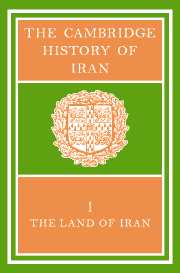Book contents
- Frontmatter
- PART 1 THE LAND
- PART 2 THE PEOPLE
- PART 3 ECONOMIC LIFE
- 15 MINERALS
- 16 INDUSTRIAL ACTIVITIES
- 17 COMMUNICATIONS, TRANSPORT, RETAIL TRADE AND SERVICES
- 18 AGRICULTURE
- 19 WATER USE IN NORTH-EAST IRAN
- 20 PASTORALISM, NOMADISM AND THE SOCIAL ANTHROPOLOGY OF IRAN
- 21 LAND REFORM IN IRAN
- PART 4 CONCLUSION
- Bibliography
- Conversion Tables
- Fig. I. Iran: physiographical.
- Plate Section
- Fig 85. Soil potentiality map of Iran.
- References
20 - PASTORALISM, NOMADISM AND THE SOCIAL ANTHROPOLOGY OF IRAN
from PART 3 - ECONOMIC LIFE
Published online by Cambridge University Press: 28 March 2008
- Frontmatter
- PART 1 THE LAND
- PART 2 THE PEOPLE
- PART 3 ECONOMIC LIFE
- 15 MINERALS
- 16 INDUSTRIAL ACTIVITIES
- 17 COMMUNICATIONS, TRANSPORT, RETAIL TRADE AND SERVICES
- 18 AGRICULTURE
- 19 WATER USE IN NORTH-EAST IRAN
- 20 PASTORALISM, NOMADISM AND THE SOCIAL ANTHROPOLOGY OF IRAN
- 21 LAND REFORM IN IRAN
- PART 4 CONCLUSION
- Bibliography
- Conversion Tables
- Fig. I. Iran: physiographical.
- Plate Section
- Fig 85. Soil potentiality map of Iran.
- References
Summary
As a modern state, Iran exerts unitary governmental and political control within its boundaries. Yet practically all nation states throughout the world contain, either relatively easily or else with difficulty, certain disparate elements which refuse wholly to conform to the wishes of the central government, however constituted, and which choose for some purposes to be in control of their own affairs and in charge of their own destinies. In this respect, Iran is no exception.
Because of aridity and the rugged nature of the terrain, Iran, despite its large size, is discontinuously occupied and utilized by its people. This in itself might well be expected to produce a certain particularism: it is difficult to imagine dose bonds existing between Balūchī tribesmen in the south-east and Turkish speaking groups of cultivators in the north-west for instance, separated as they are by vast and comparatively empty areas. Both groups occupy niches within one body politic, but linguistically as well as in more general cultural terms, they show considerable differences. Again, for some purposes there could be said to be a great social chasm dividing the nomadic tribesmen of Fārs and the sophisticated urbanites of Tehrān. The oil installation workers on the Persian Gulf are far removed socially from the peasantry of the central Iranian plateau; there exists between them a substantial technological and ideological gap which is difficult to bridge.
Yet, within the country, there also exists a certain social mobility which, though its advent might possibly be dated to the arrival of Islam in the seventh century A.D., increases in volume and accelerates with the passing years.
- Type
- Chapter
- Information
- The Cambridge History of Iran , pp. 611 - 683Publisher: Cambridge University PressPrint publication year: 1968
References
- 5
- Cited by



